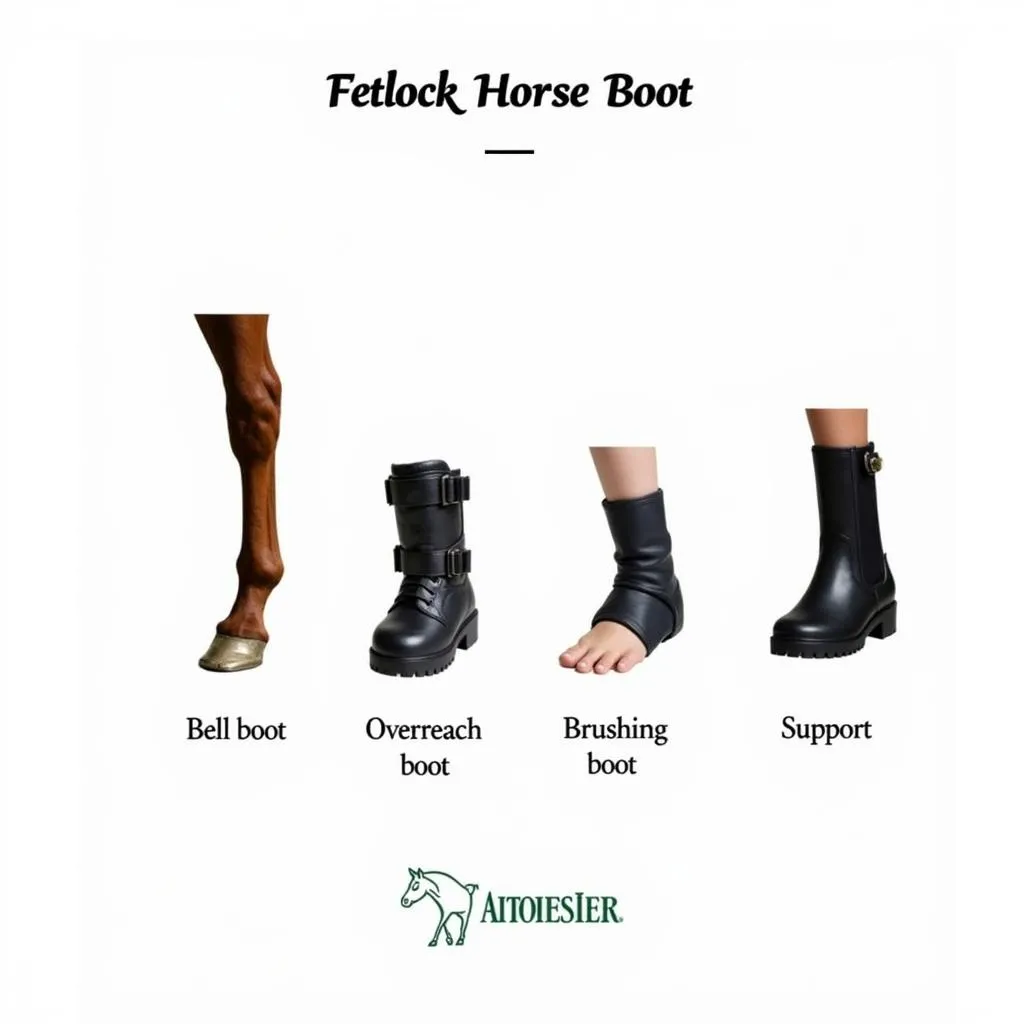Fetlock Horse Boots are a vital piece of equipment for any equestrian, offering protection and support for your horse’s legs. But with so many different types and brands available, choosing the right boots can be a daunting task. This comprehensive guide will break down everything you need to know about fetlock horse boots, from their purpose and benefits to choosing the right ones for your horse.
Why Use Fetlock Horse Boots?
Fetlock horse boots are designed to protect your horse’s legs from a range of potential injuries. They act as a barrier between your horse’s legs and the environment, preventing scrapes, cuts, and other wounds. These boots are especially important for horses that are:
- Prone to leg injuries: Some breeds are more susceptible to leg injuries than others, or your horse may have a history of past injuries.
- Engaged in strenuous activities: Horses participating in high-impact activities like jumping, racing, or trail riding are at a higher risk of leg injuries.
- Being transported: Traveling in trailers or vans can expose horses to abrasions and impact injuries.
- Grazing in rough terrain: Horses grazing in rocky or thorny areas can easily injure their legs.
Types of Fetlock Horse Boots
Fetlock horse boots come in a variety of designs, each offering different levels of protection and support. The most common types include:
1. Bell Boots:
- Purpose: Bell boots are designed to protect the fetlock joint and pastern from injuries caused by the horse’s own hind shoes.
- Features: Bell boots are typically made of tough materials like leather or neoprene and often feature a bell-shaped design that covers the fetlock joint.
- Best For: Horses that are prone to kicking themselves, horses with pastern injuries, or horses undergoing recovery from tendonitis.
2. Overreach Boots:
- Purpose: Overreach boots are designed to prevent the horse’s hind shoes from striking the front legs.
- Features: They are typically shorter than bell boots and are often made of leather or nylon.
- Best For: Horses that tend to overreach, especially when jumping or galloping.
3. Brushing Boots:
- Purpose: Brushing boots are designed to protect the horse’s legs from contact with other horses or obstacles.
- Features: Brushing boots usually have a thick, padded layer that cushions the horse’s legs. They often come in different lengths to cover the fetlock, pastern, or even the cannon bone.
- Best For: Horses that are prone to bumping into other horses, horses that graze in rough terrain, or horses that are being transported.
4. Support Boots:
- Purpose: Support boots offer extra support and stability to the fetlock joint.
- Features: They typically have a combination of padding and stiff materials that provide both protection and support.
- Best For: Horses with fetlock joint problems, horses recovering from injuries, or horses participating in strenuous activities.
Choosing the Right Fetlock Horse Boots
Selecting the right fetlock horse boots for your horse requires careful consideration of several factors:
- Horse’s Activity Level: If your horse is primarily a pasture horse, simple bell boots may suffice. However, if your horse is highly active, you may need more robust brushing boots or support boots.
- Horse’s History of Injuries: If your horse has a history of fetlock injuries, you may need to prioritize boots that offer extra protection and support.
- Horse’s Size and Build: Fetlock boots should fit snugly but comfortably, without constricting circulation.
- Boot Material: Leather boots are durable but can be stiff, while neoprene boots are more flexible but may not be as long-lasting.
- Boot Features: Consider features like ventilation, padding, and closures to ensure a comfortable and secure fit.
“Fetlock horse boots can be a valuable investment for your horse’s health and well-being,” says renowned equine veterinarian Dr. Emily Carter. “By providing extra protection and support, these boots can help prevent serious injuries and keep your horse safe and sound.”
Tips for Using Fetlock Horse Boots
- Proper Fit: Ensure the boots are a snug but comfortable fit, allowing for adequate circulation.
- Regular Inspection: Check for any signs of wear or damage and replace the boots as needed.
- Cleaning and Maintenance: Regularly clean and maintain the boots to prevent bacteria and dirt buildup.
FAQs
Q: How often should I change my horse’s fetlock boots?
A: Ideally, you should change the boots every 6-12 months or sooner if you see any signs of wear and tear.
Q: What are the best fetlock boots for horses with tendonitis?
A: Support boots or boots with specialized tendon support features can be helpful for horses with tendonitis.
Q: Can I use fetlock boots on all four legs?
A: It’s generally recommended to use fetlock boots only on the legs that need extra protection, such as the hind legs for overreaching prevention.
Q: Are fetlock boots always necessary?
A: While fetlock boots can be beneficial, they are not always necessary. Factors like your horse’s activity level, breed, and individual needs should be considered.
Conclusion
Fetlock horse boots are an essential piece of equipment for protecting your horse’s legs. By understanding the different types of boots, choosing the right ones for your horse, and following proper usage guidelines, you can ensure that your horse’s legs are well-protected and ready for any activity.
 Fetlock Horse Boots Types
Fetlock Horse Boots Types
Remember, if you have any questions or need further assistance in choosing the right fetlock horse boots for your horse, don’t hesitate to contact us. We are always happy to help!
Contact Information:
Phone Number: 0772127271
Email: [email protected]
Address: QGM2+WX2, Vị Trung, Vị Thuỷ, Hậu Giang, Việt Nam
We have a dedicated customer support team available 24/7 to assist you with all your equine needs.